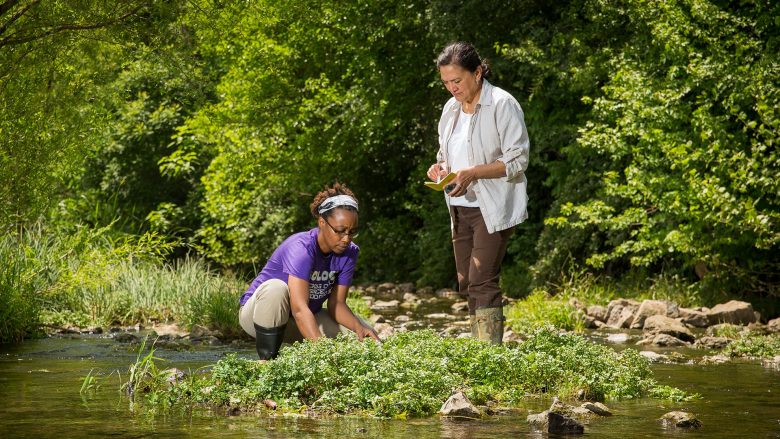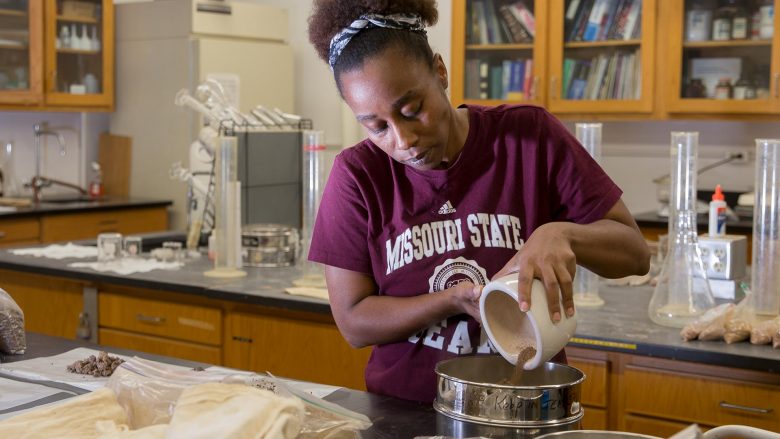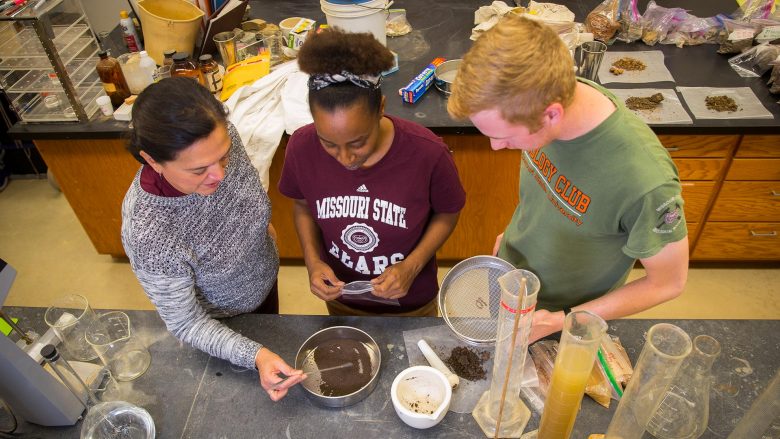Trouble under the surface
It’s abundant: Approximately 71 percent of the Earth’s surface is covered in water, and 96.5 percent of it is in the oceans.
The other 3.5 percent of the water supply fills lakes, streams, ponds and aquifers; forms icecaps and glaciers; and evaporates or exists inside lifeforms — like us.
For a resource that is so in-demand, it’s important to consider how long it will remain.
The other 3.5 percent
No one really knows how long the water supply will last, according to Dr. Melida Gutierrez, professor of geology at Missouri State University. It’s a question she gets asked frequently as she presents at international conferences about water contamination and the sustainability of the
water supply.
Though the quantity is a concern for the environment and farming, Gutierrez is most focused on the quality of this valuable resource. She conducts environmental studies to determine levels of contaminants and to help prevent contamination from certain waste.
For her two primary projects, she’s selected two areas she calls home: southwest Missouri and Chihuahua, Mexico.
Arsenic in water
The river Gutierrez studies in northern Mexico, Rio Conchos, was said to contain high levels of arsenic, and it was feared that the river was contaminating the groundwater supply.
She collaborated with her colleagues from the University of Chihuahua, who went to the wells and collected hundreds of water samples. It’s not as simple as dipping a test tube in a river or well, though. The team works for months calibrating the sampling containers and instruments and meeting with the local farmers to explain the process and gain approval and access to the wells.
The sampling and initial analysis must be completed quickly since the samples are reliable for no more than three weeks. These data and GPS information were then sent to Gutierrez who spent months analyzing and interpreting.
“Actually, global warming is bringing more rains to the area (in Mexico) and so it’s increasing the recharge. Everyone was so worried that there was going to be less water – the drought was going to be more intense. For that particular region, for the past 10 years they have had more rain.” — Dr. Melida Gutierrez
Contaminants were revealed in the samples, though not to the toxic level that had been previously described and feared.
To get to the heart of the matter, Gutierrez secured several faculty research grants to obtain data from the Mexican Geological Survey. Then, she worked with Dr. Daniel Nunez from the Advanced Materials Research Center (CIMAV) in Durango, Mexico, to build a comprehensive view of the landscape near the river. Nunez programmed elevation, vegetation, bodies of water and other information about the area into the geographical information system, known as GIS.
From that, Gutierrez extracted information like possible relationships between the land and water.
“I started looking at the river and how it changes quality downstream. Then I thought about the sediment, so I tested that,” she said. “It’s a trick of chemistry to know what to sample. The sediment traps the contaminants. By looking at the sediment, you have the history of contamination.”
So her investigation of the water led to further research, with each study taking months to complete.
“The same research is going to take you to areas that are connected that are not well understood. You never know where it’s going to take you next,” she said.
After sampling and testing the sediments, they began seeing the interconnection with the groundwater and began a round of tests with the groundwater.
In this case, Gutierrez found the cause of the contamination was natural. The aquifers — rock formations that store water — contained some volcanic glass that was weathering in the water, causing the groundwater to be contaminated.
“That’s part of being a scientist — that you see an interconnection — things that you might think are very separate,” she said. “All of a sudden you find that one causes the other one or they’re interconnected somehow.”

Photo by Jesse Scheve
Getting the message across
To extend the reach of her research, Gutierrez publishes the results in a multitude of ways, from top-tier academic journals in English and Spanish — many of her collaborators don’t speak English — to more accessible publications, like farming magazines.
Dr. Maria Teresa Alarcon Herrera, director of advanced materials investigation at CIMAV-Durango, has been a co-author on many of her latest articles. More than a decade ago, the two connected at a conference in Delicias, Mexico, where they realized their interests aligned.
“This is an urgent matter to address as underground water is the main source of drinking water in the north of Mexico,” said Alarcon.
Gutierrez has published more than 30 articles in the last 10 years. Her work has had an impact, and it is being referenced to teach the public sustainable ways to use groundwater.
“You want your system to be sustainable. Fluctuations are normal, but if they just go down, that’s not sustainable. That means you’re going to end up having no water or very bad quality water because as you go deeper and deeper there’s more and more salty water,” said Gutierrez.
How is there salty water underground? She explains that approximately 95 million years ago, the state of Chihuahua was an ocean. This history led to the salinity in the soil, which can kill plants and effectively destroy the productivity of the soil.
The flow of information
The flow of information isn’t as free in Mexico, Gutierrez noted, and she sees it causing a severe lack of trust. In fact, she thinks the water agencies have a lot of work to do on becoming transparent.
“Some colleagues who work for the government must report only things the government wants to hear,” Gutierrez said, but she doesn’t have that restriction. “I tell the people that water is a system where there are entries and withdrawals, so it all depends on your actions.”
Since the people of Chihuahua depend completely upon groundwater for drinking, they’re obviously concerned about the dropping reserve. Because of this, Gutierrez said, many take more water than they need as a precaution. This perpetuates the problem.
“It’s like going to a doctor and the doctor doesn’t tell you what you have,” she said. “You’re feeling bad, then you start fearing the worst. That’s how the farmers are: They are fearing the worst and making it come true.”
The water table is dropping, according to Gutierrez’s colleagues, but there is not a system in place for monitoring wells. Gutierrez has been encouraging the community to rise up and demand monitors so they can understand the relationship between what they take and what is available.
“What we have in Missouri, for example, we have monitoring wells. I can go online and check what the level is and what it was last month and compare it to last year. The information is available to everyone, and it’s free. Over there, they don’t have that,” she said.
She’s a geochemist with an environmental bend, and she envisions her role as an educator extends far beyond the classroom. She provides access to valid information in order to ensure more environmentally sound decisions are made at the individual and global level.
“Show them what to look for — this is science,” she said. “We do facts, so that others can apply that and make the best decision.”

Photo by Jesse Scheve
A dirty job to find clarity
Gutierrez, who’s been at Missouri State for approximately 23 years, involves her students in her research, but can’t take them to Mexico to do the hands-on water sample collections due to the expense and safety concerns. That’s why she gets them involved in her sediment collection and studies in Aurora, Missouri.
The students collected hundreds of pounds of sediment and laid the samples on laboratory work tables to air dry. Next, they sieved the samples to remove all particles larger than two millimeters. Then they bagged the sediment — five grams at a time — and shipped the samples to a commercial lab in Reno, Nevada, for initial analysis.
From there, Gutierrez used these data to determine the chemistry of the water.
“I was in college in the 1970s and the environment was the big issue, so I really wanted to do something.” — Dr. Melida Gutierrez
Instead of fearing arsenic as in Mexico, they were testing for zinc — in part due to the history of zinc and lead mining in Missouri. Though zinc is regularly found, it is extremely toxic when paired with cadmium, another heavy metal sometimes associated with mining waste. In fact, it can destroy many aquatic habitats.
“You go there and physically you see no signs of former mining. Everything is clean, leveled and healthy-looking,” she said. “Going to a stream setting is going to tell you if there’s still contamination or not.”
After collecting more than 200 different sediment samples — it’s never enough, she noted — and mapping the area, she worked with Dr. Sho-Sheng “Derek” Wu, geospatial information technician at Missouri State, on the GIS.
The team then tested the groundwater and found a very limited area where contamination existed. More investigation would be beneficial, Gutierrez noted.
“We have one sample with a lot of zinc right next to one that has very little, so you want to make sure,” she said. “By taking more samples, by knowing the area, by knowing what affects the area and knowing which medium to sample, you get as close to undeniable evidence as you can.”
Since Missouri is known for its abundance of outdoor activities like hiking, fishing, canoeing and camping, Gutierrez routinely highlights the effects on natural habitats or outdoor resources in order to elevate her students’ interests in chemistry.
And she is quite proud of the ownership her undergraduate students take when they are out in the field.
Jameelah Rodriguez, an Army veteran who is an undergraduate student in the geology department, quickly picked up the tactics of collecting samples, reading the maps and setting sights on the next location. To Gutierrez, who wants to make a difference, watching Rodriguez take a leadership role on the site was gratifying.

Photo by Jesse Scheve
Better together
In addition to placing a great emphasis on expanding her students’ opportunities, Gutierrez is an advocate for the power of collaboration.
This value is added when she completes projects with students, colleagues in her department, scientists at other universities and even her husband, Dr. Kevin Mickus, distinguished professor of geology at Missouri State.
Gutierrez and Mickus published an article in Science of the Total Environment. It was an overview of the presence of lead-zinc wastes around the world and the problems associated with this waste being exposed to the elements. It was the first review-paper published addressing this particular type of mining wastes.
She noted that for this project in particular, his knowledge about metals that naturally occur across the globe was extremely helpful.
Gutierrez added, “You work on something different. Everyone looks at it from a different perspective, so you get better.”
- Story by Nicki Donnelson
- Main photo by Bob Linder
- Video by Chris Nagle


2 Responses